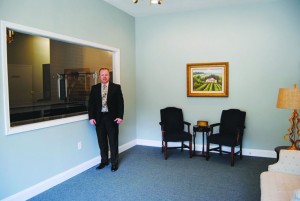The age-old practice of cremating a loved one out in an open air “Pyre” (a topic we have covered prior) is still practiced throughout the world, including in some private locations in the US reserved exclusively for certain religious groups. What many people are unaware of is another indoor form called “witnessing a cremation” or “viewing a cremation” is available in many of our modern day funeral homes and crematoriums.
A plain plastic or cardboard box is typically provided, or the family can purchase or make a cremation urn to hold the cremation ashes of their beloved one.
This “witnessing” allows the immediate family members the opportunity to be present when their loved one is placed into the cremation chamber or “retort.” Some funeral homes or crematoriums only allow the attending family to witness the body entering the retort while others allow the family to sit to watch the full length of the cremation. This allows them to be present when the ashes are removed from the cremation chamber, placed in a box and handed (on the spot) to the family member. A plain plastic or cardboard box is typically provided, or the family can purchase or make a cremation urn to hold the cremation ashes of their beloved one. A family member is allowed to use any type of vessel they wish.
In its least attractive form, the family member stands in a bare bones and often aging, industrial-like room in which the retort sits. Retorts come in all shapes and locations, and not all are shiny state-of-the-art.
This modern option is provided to families in a variety of situated experiences. In its least attractive form, the family member stands in a bare bones and often aging, industrial-like room in which the retort sits. Retorts come in all shapes and locations, and not all are shiny state-of-the-art. Some crematories, or funeral homes, have specially designed “witnessing rooms” where homelike seating is provided to sit and watch. Some have a glass wall or window to witness the cremation while others provide an open space specially designed for the occasion. This practice of viewing a cremation is not common, but it is growing in popularity.

A personal cremation urn containing remains of a loved one can be any type you desire
(Credit: spiritualresearchfoundation.org)
Rarely do families opt to have the body placed in a casket to only be burned, but by law in most states, a cardboard box must be purchased. In rare situations, a facility may allow only a shroud to cover the person being cremated. A cremation typically takes three to five hours depending on the size of the person.
Witnessing a cremation is a practice used by some American religious groups, including the Hindus, in a ceremony where a specific family member pushes the retort button as a symbol for lighting the fire. But witnessing a cremation can be for anyone for any number of reasons. Some simply need the comfort of closure by being present as the body is placed in the chamber. Others have the need to be present for the length of the cremation to watch as the ashes are removed, prepared and then handed to them. They have the personal need to be sure they have the ashes of their beloved. There are always some larger bone fragments remaining, about the size of a thin stick to draw a line in the sand. These are pulverized by a small special machine. The size of the remaining bones depends on the temperature of the retort. Many funeral homes do not have their own crematory, so witnessing is not always an option.

 Viewing or Witnessing a Cremation in America
Viewing or Witnessing a Cremation in America




 First the Wealth Gap, Now the U.S. Has a Growing Health Gap
First the Wealth Gap, Now the U.S. Has a Growing Health Gap
 How to Comfort A Dying Loved One
How to Comfort A Dying Loved One
 Our Annual Seven Holiday Gifts for Someone Who Is Grieving, 2024 Edition
Our Annual Seven Holiday Gifts for Someone Who Is Grieving, 2024 Edition














